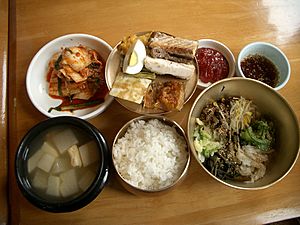Heotjesatbap facts for kids
| Heotjesatbap | |
 |
|
Quick facts for kids Korean name |
|
|---|---|
| Hangul |
헛제삿밥
|
| Hanja | |
| Revised Romanization | Heotjesatbap |
| McCune–Reischauer | Hŏtjesatbap |
Heotjesatbap (Korean: 헛제삿밥), also called heotjesabap, is a special Korean dish. It's a type of bibimbap, which means "mixed rice". But unlike most bibimbap that uses spicy gochujang (hot pepper paste), Heotjesatbap uses soy sauce (ganjang).
This dish is made with white rice topped with different kinds of namul (young sprouted vegetables). It also often comes with grilled fish and some jeon (Korean pancakes).
What is Heotjesatbap?
The name Heotjesatbap literally means "mock jesa meal." A jesa is a traditional Korean ceremony. During a jesa, families honor their ancestors who have passed away. They prepare many dishes and offer them to the spirits of their relatives.
In a jesa ceremony, family members carefully place food on a table. They also pour rice wine into cups, just like they would for important guests. After setting out the food, the family leaves the room. This gives the spirits time to "enjoy" the meal.
After a short while, the oldest male relative clears his throat. This signals to the spirits that the family is coming back. Then, the family takes the food to another room. Everyone eats and drinks the offerings together. This act helps them feel connected to their ancestors.
History of Heotjesatbap
This unique dish comes from Andong, a city in Gyeongsangbuk-do, Korea. Andong was famous during the Joseon Dynasty (1392-1897). Many scholars, called seonbi, lived and studied there.
During that time, food was not always easy to find. Some seonbi scholars, who belonged to the noble yangban class, found a clever way to eat these special foods. They would prepare the ceremonial dishes for a "fake" jesa. This allowed them to enjoy the delicious food themselves.
These meals were called "fake" because they were eaten by people. Normally, jesa food would be covered with incense ash during the ceremony. This made it not good to eat afterwards. Heotjesatbap was often eaten as a late-night snack by scholars who were studying hard.
Images for kids
See also
 In Spanish: Heotjesabap para niños
In Spanish: Heotjesabap para niños


